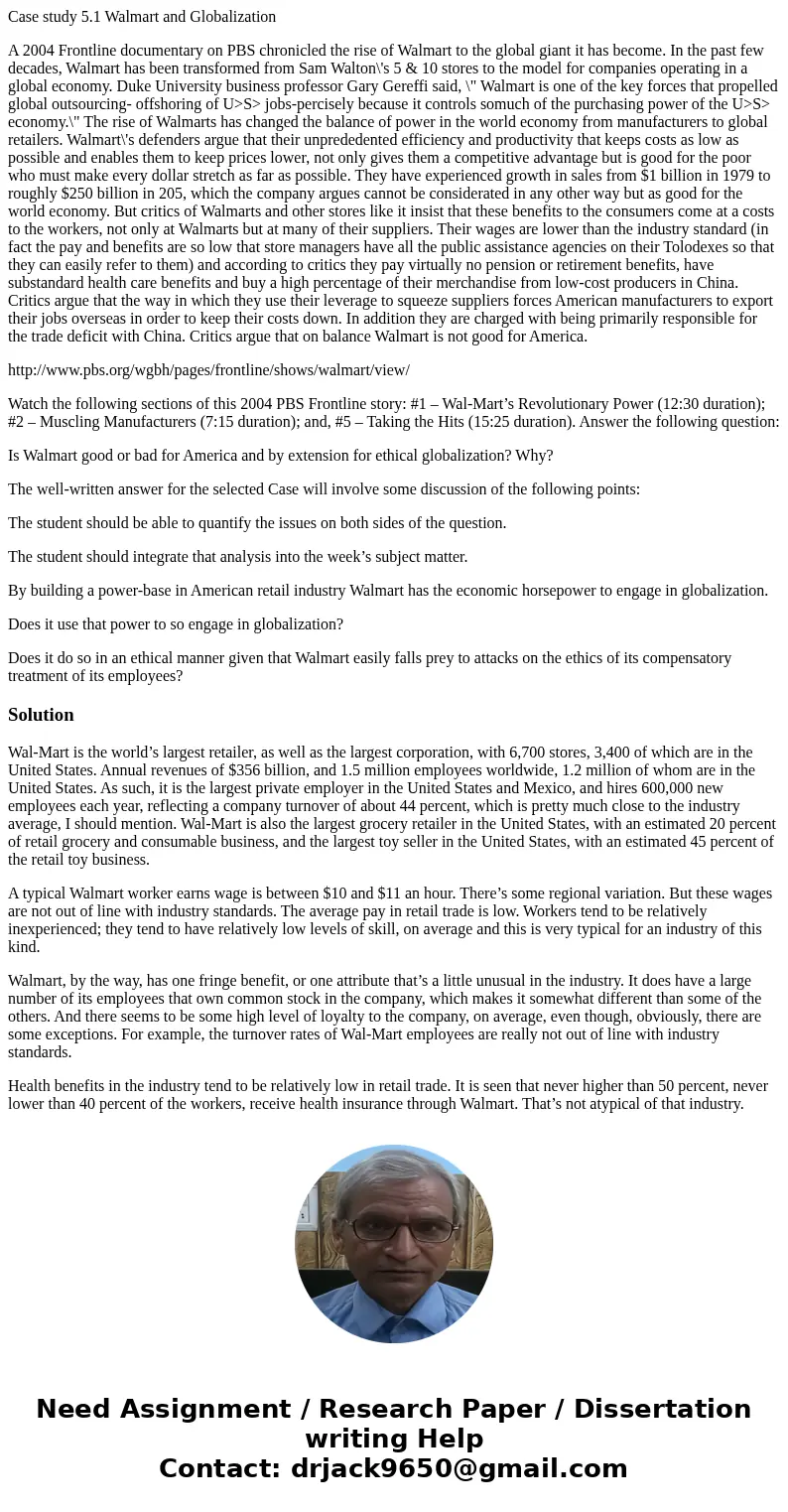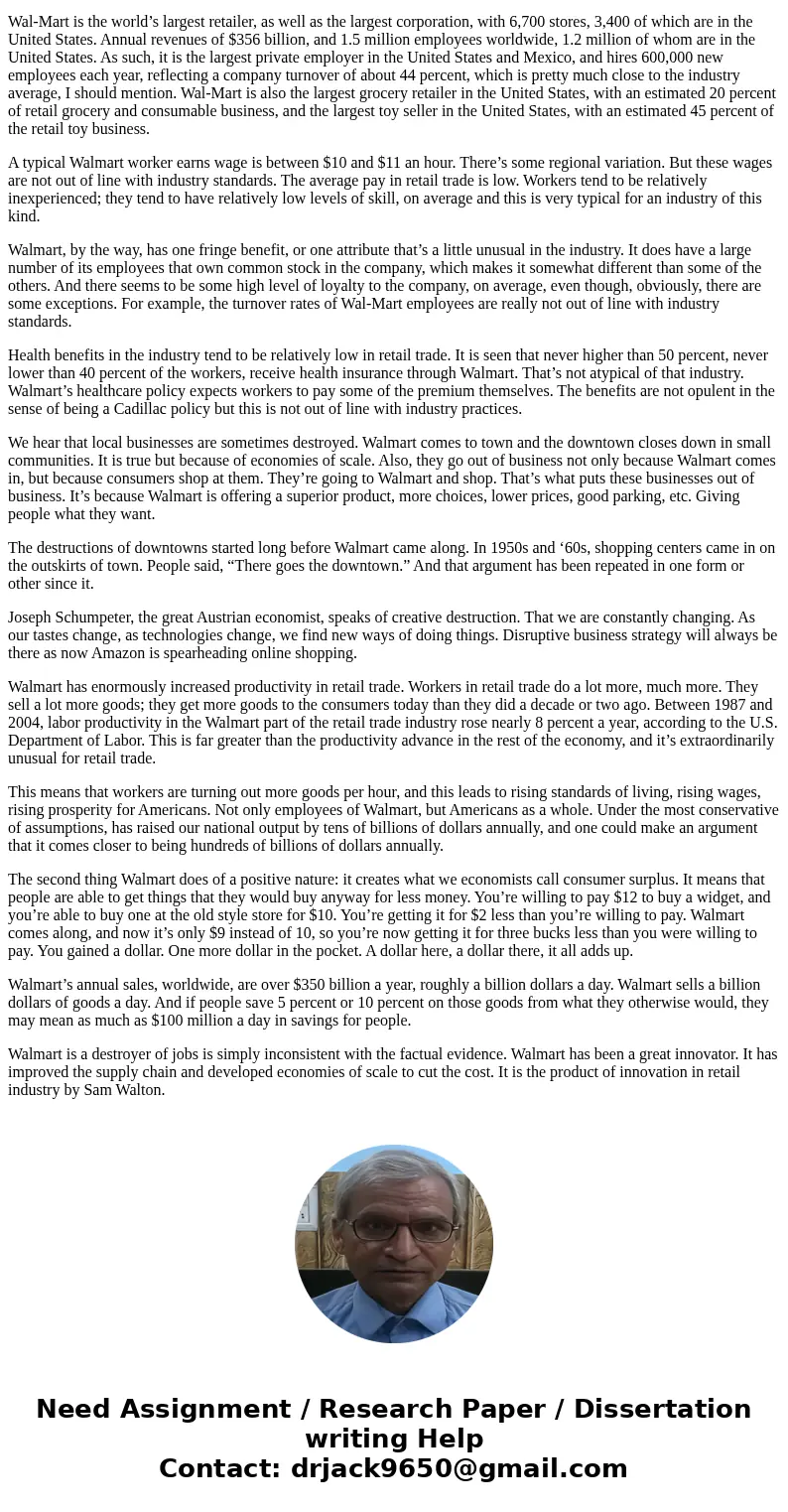Case study 51 Walmart and Globalization A 2004 Frontline doc
Case study 5.1 Walmart and Globalization
A 2004 Frontline documentary on PBS chronicled the rise of Walmart to the global giant it has become. In the past few decades, Walmart has been transformed from Sam Walton\'s 5 & 10 stores to the model for companies operating in a global economy. Duke University business professor Gary Gereffi said, \" Walmart is one of the key forces that propelled global outsourcing- offshoring of U>S> jobs-percisely because it controls somuch of the purchasing power of the U>S> economy.\" The rise of Walmarts has changed the balance of power in the world economy from manufacturers to global retailers. Walmart\'s defenders argue that their unprededented efficiency and productivity that keeps costs as low as possible and enables them to keep prices lower, not only gives them a competitive advantage but is good for the poor who must make every dollar stretch as far as possible. They have experienced growth in sales from $1 billion in 1979 to roughly $250 billion in 205, which the company argues cannot be considerated in any other way but as good for the world economy. But critics of Walmarts and other stores like it insist that these benefits to the consumers come at a costs to the workers, not only at Walmarts but at many of their suppliers. Their wages are lower than the industry standard (in fact the pay and benefits are so low that store managers have all the public assistance agencies on their Tolodexes so that they can easily refer to them) and according to critics they pay virtually no pension or retirement benefits, have substandard health care benefits and buy a high percentage of their merchandise from low-cost producers in China. Critics argue that the way in which they use their leverage to squeeze suppliers forces American manufacturers to export their jobs overseas in order to keep their costs down. In addition they are charged with being primarily responsible for the trade deficit with China. Critics argue that on balance Walmart is not good for America.
http://www.pbs.org/wgbh/pages/frontline/shows/walmart/view/
Watch the following sections of this 2004 PBS Frontline story: #1 – Wal-Mart’s Revolutionary Power (12:30 duration); #2 – Muscling Manufacturers (7:15 duration); and, #5 – Taking the Hits (15:25 duration). Answer the following question:
Is Walmart good or bad for America and by extension for ethical globalization? Why?
The well-written answer for the selected Case will involve some discussion of the following points:
The student should be able to quantify the issues on both sides of the question.
The student should integrate that analysis into the week’s subject matter.
By building a power-base in American retail industry Walmart has the economic horsepower to engage in globalization.
Does it use that power to so engage in globalization?
Does it do so in an ethical manner given that Walmart easily falls prey to attacks on the ethics of its compensatory treatment of its employees?
Solution
Wal-Mart is the world’s largest retailer, as well as the largest corporation, with 6,700 stores, 3,400 of which are in the United States. Annual revenues of $356 billion, and 1.5 million employees worldwide, 1.2 million of whom are in the United States. As such, it is the largest private employer in the United States and Mexico, and hires 600,000 new employees each year, reflecting a company turnover of about 44 percent, which is pretty much close to the industry average, I should mention. Wal-Mart is also the largest grocery retailer in the United States, with an estimated 20 percent of retail grocery and consumable business, and the largest toy seller in the United States, with an estimated 45 percent of the retail toy business.
A typical Walmart worker earns wage is between $10 and $11 an hour. There’s some regional variation. But these wages are not out of line with industry standards. The average pay in retail trade is low. Workers tend to be relatively inexperienced; they tend to have relatively low levels of skill, on average and this is very typical for an industry of this kind.
Walmart, by the way, has one fringe benefit, or one attribute that’s a little unusual in the industry. It does have a large number of its employees that own common stock in the company, which makes it somewhat different than some of the others. And there seems to be some high level of loyalty to the company, on average, even though, obviously, there are some exceptions. For example, the turnover rates of Wal-Mart employees are really not out of line with industry standards.
Health benefits in the industry tend to be relatively low in retail trade. It is seen that never higher than 50 percent, never lower than 40 percent of the workers, receive health insurance through Walmart. That’s not atypical of that industry. Walmart’s healthcare policy expects workers to pay some of the premium themselves. The benefits are not opulent in the sense of being a Cadillac policy but this is not out of line with industry practices.
We hear that local businesses are sometimes destroyed. Walmart comes to town and the downtown closes down in small communities. It is true but because of economies of scale. Also, they go out of business not only because Walmart comes in, but because consumers shop at them. They’re going to Walmart and shop. That’s what puts these businesses out of business. It’s because Walmart is offering a superior product, more choices, lower prices, good parking, etc. Giving people what they want.
The destructions of downtowns started long before Walmart came along. In 1950s and ‘60s, shopping centers came in on the outskirts of town. People said, “There goes the downtown.” And that argument has been repeated in one form or other since it.
Joseph Schumpeter, the great Austrian economist, speaks of creative destruction. That we are constantly changing. As our tastes change, as technologies change, we find new ways of doing things. Disruptive business strategy will always be there as now Amazon is spearheading online shopping.
Walmart has enormously increased productivity in retail trade. Workers in retail trade do a lot more, much more. They sell a lot more goods; they get more goods to the consumers today than they did a decade or two ago. Between 1987 and 2004, labor productivity in the Walmart part of the retail trade industry rose nearly 8 percent a year, according to the U.S. Department of Labor. This is far greater than the productivity advance in the rest of the economy, and it’s extraordinarily unusual for retail trade.
This means that workers are turning out more goods per hour, and this leads to rising standards of living, rising wages, rising prosperity for Americans. Not only employees of Walmart, but Americans as a whole. Under the most conservative of assumptions, has raised our national output by tens of billions of dollars annually, and one could make an argument that it comes closer to being hundreds of billions of dollars annually.
The second thing Walmart does of a positive nature: it creates what we economists call consumer surplus. It means that people are able to get things that they would buy anyway for less money. You’re willing to pay $12 to buy a widget, and you’re able to buy one at the old style store for $10. You’re getting it for $2 less than you’re willing to pay. Walmart comes along, and now it’s only $9 instead of 10, so you’re now getting it for three bucks less than you were willing to pay. You gained a dollar. One more dollar in the pocket. A dollar here, a dollar there, it all adds up.
Walmart’s annual sales, worldwide, are over $350 billion a year, roughly a billion dollars a day. Walmart sells a billion dollars of goods a day. And if people save 5 percent or 10 percent on those goods from what they otherwise would, they may mean as much as $100 million a day in savings for people.
Walmart is a destroyer of jobs is simply inconsistent with the factual evidence. Walmart has been a great innovator. It has improved the supply chain and developed economies of scale to cut the cost. It is the product of innovation in retail industry by Sam Walton.


 Homework Sourse
Homework Sourse